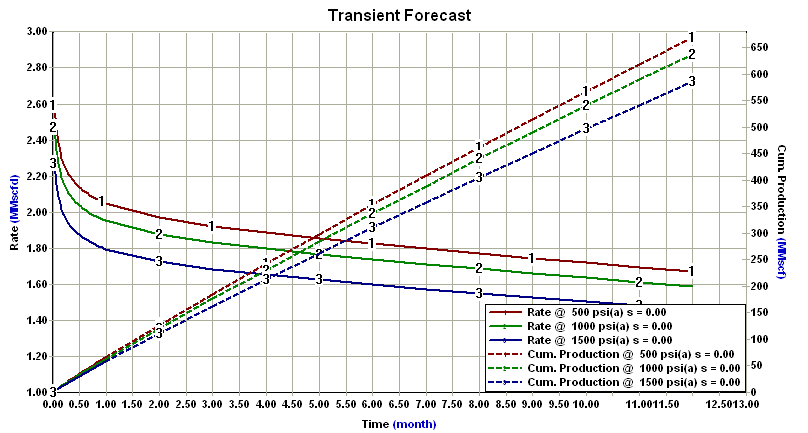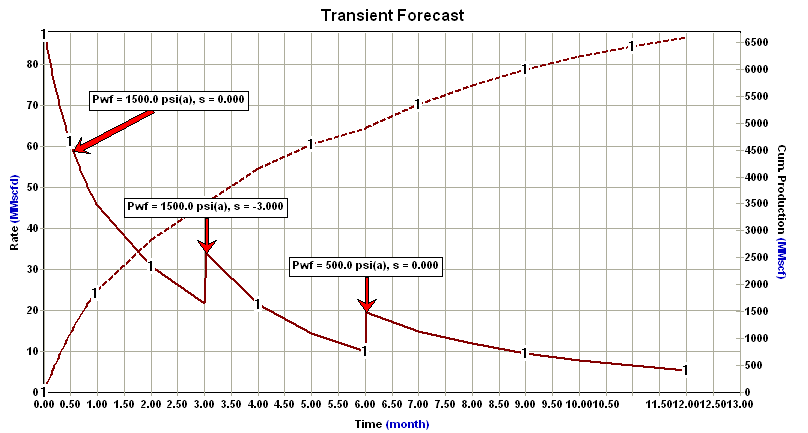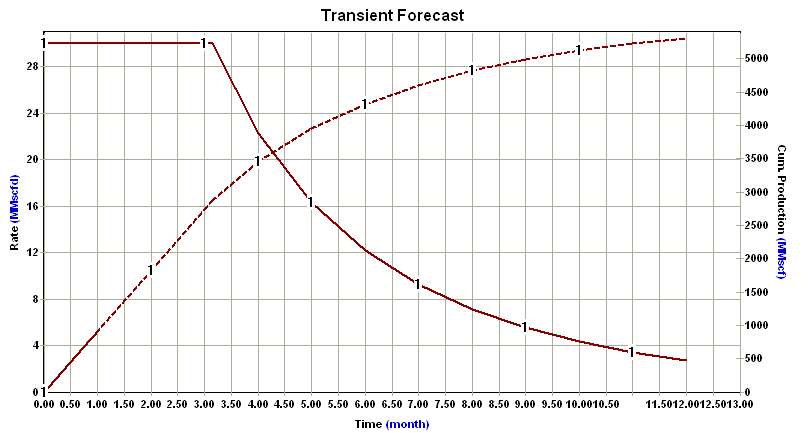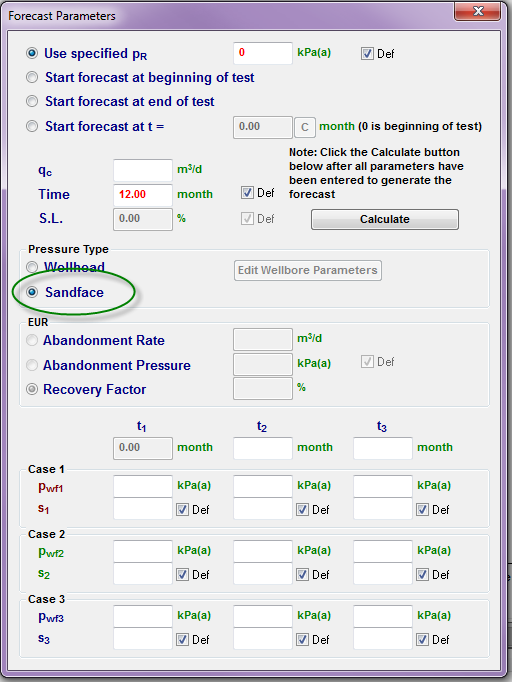Transient Forecast
After the flow regimes have been identified and values for reservoir parameters have been obtained, an appropriate model is selected to represent the reservoir. This model makes use of the rate history to create a pressure response, which is then compared to the actual pressure data recorded during the test. The model parameters are adjusted until a history match of the pressures has been obtained. When the pressure response of the model is the same as the pressure response of the reservoir, the modeling is complete and a forecast can be done.
The forecast gives the analyst an understanding of the reservoir and the economics of the well. For gas or oil reservoirs, it can help illustrate and quantify the value of adding suction, improving skin, or changing the design of the gathering system. Note that for oil reservoirs, the forecast assumes constant compressibility, constant fluid saturations, and single-phase flow; therefore, it is only valid above the bubble point pressure, and long-term forecasts may not be reliable.
The forecast below is a plot of rate and cumulative production versus time for a specified back pressure. The calculations are done on a daily basis for the first month, and then on a monthly basis up to the specified forecast time, and consist of sequential material balance and deliverability calculations. Multiple forecast cases (up to three) can be performed as shown in the plot below.

The back-pressure and skin can be changed during the course of the forecast. The following plot shows the effect on the rate forecast of an acid treatment three months after the test, as well as the effect of adding a compressor six months after the test:

A contract rate can also be specified to determine how long that rate can be maintained at the specified back-pressure as shown in the plot below.

| Note: | If a contract rate is not specified, the maximum capacity of the well against the specified back pressure is calculated. |
Forecast Parameters Dialog Box

- Use Specified pR — starts the forecast at the specified reservoir pressure. This is the default option and uses the final average reservoir pressure calculated from the production data and the model.
- Start forecast at beginning of test — starts the forecast at the initial average reservoir pressure calculated from the production data and model.
- Start forecast at end of test — starts the forecast at the final average reservoir pressure calculated from the production data and model.
- Start forecast at t = — starts the forecast at the average reservoir pressure calculated at the specified time in months from the beginning of the test using the production data and model.
- qc — specifies the contract rate to use in the forecast. This rate is maintained as long as possible at the specified flowing pressure. Rate decline occurs when this rate can no longer be supported.
- Time — specifies the total time or duration of the forecast. The default is 12 months.
- S.L. — specifies the surface loss, which is the difference (expressed as a %) between the raw gas and the sales gas. It represents the amount of gas that is used in the production operation, such as powering a compressor on the gathering system, heating, dehydration, removal of CO2, and H2S, dealing with leaks, etc.
- Calculate — click this button to generate the forecast based on the current forecast parameters.
- Wellbore — specifies that the flowing pressures used are at wellhead conditions. When using this option, the wellbore parameters also need to be specified to convert the wellhead flowing pressure to sandface conditions. Note that this option requires more computational time as an iterative process is required to convert the wellhead pressure to sandface. This is due to the fact that the conversion is dependent on the rate being forecast, and the rate being forecast is dependent on the sandface pressure. Thus, an iterative process is required to solve this scenario.
- Sandface — specifies that the flowing pressures used are at sandface conditions.
- Edit Wellbore Parameters — click this button to open the Wellbore Properties dialog box and modify the current wellbore configuration. This option is only available when the Wellhead option (see above) is active.
- Abandonment Rate — specifies the abandonment rate to determine the Estimated Ultimate Recoverable (EUR) fluid.
- Abandonment Pressure — specifies the abandonment reservoir pressure to determine the Estimated Ultimate Recoverable (EUR) fluid. The default value is 10 percent of the reservoir pressure (pR).
- Recovery Factor — specifies the recovery factor (expressed as a %) of fluid. This represents the amount of fluid that is desired for recovery.
- pwf1 — specifies the case 1 flowing pressure to run the forecast at. This value must be less than the reservoir pressure (pR).
- s1 — specifies the case 1 skin to run the forecast at. The default value is the skin specified in the model.
- pwf2 — specifies the case 2 flowing pressure to run the forecast at. This value must be less than the reservoir pressure (pR).
- s2 — specifies the case 2 skin to run the forecast at. The default value is the skin specified in the model.
- pwf3 — specifies the case 3 flowing pressure to run the forecast at. This value must be less than the reservoir pressure (pR).
- s3 — specifies the case 3 skin to run the forecast at. The default value is the skin specified in the model.
- t2 — specifies the time in months to make either a flowing pressure (add compression), or skin (stimulate well) change. This can be applied to all three cases.
- t3 — specifies the time in months to make either a flowing pressure (add compression), or skin (stimulate well) change. This can be applied to all three cases.